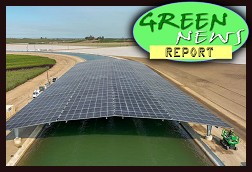
"On March 10 they had a multibillion-dollar asset that generated a lot of electricity," David Lochbaum, director of nuclear safety at the Massachusetts-based Union of Concerned Scientists told reporters on a conference call today. "On March 11 they had a multibillion-dollar liability that’s going to cost a lot to clean up."
"They’ve made considerable progress bringing equipment to the plant and restoring power," he said. "But they’re not out of the woods yet. They are working with razor-thin margins."
Japanese officials remain appropriately cautious at this hour as well, but positive signs for stabilization at the stricken Fukushima Daiichi nuclear plant continued on Tuesday...
 Each of the stricken reactors has now been linked to outside power, even as workers attempt to restore the pumps and cooling systems at each, so they can actually make use of that electricity. Alex Martin at The Japan Times offers this very helpful, straight-forward summary of the latest status of each reactor at the crippled plant as of Tuesday...
Each of the stricken reactors has now been linked to outside power, even as workers attempt to restore the pumps and cooling systems at each, so they can actually make use of that electricity. Alex Martin at The Japan Times offers this very helpful, straight-forward summary of the latest status of each reactor at the crippled plant as of Tuesday...
Firefighters sprayed a massive amount of water onto the spent nuclear fuel pool at the No. 3 reactor, while restarting similar efforts at the No. 4 reactor, according to Tokyo Electric Power Co.
Although white smoke — possibly steam — billowed continuously from the buildings housing the No. 2 and No. 3 reactors, Tepco said work could proceed as radiation levels didn't surge at the site.
Defense Minister Toshimi Kitazawa said he believes the smoke rising from the No. 2 reactor was vapor given off by the water that has been sprayed, while the blackish smoke briefly detected Tuesday at the No. 3 reactor was likely rubble that caught fire following a rise in temperature.
Work to restore electricity resumed at 8 a.m. Tuesday.
With power restored to the No. 3 reactor, all of the plant's six reactors have now been hooked up so that key equipment can be restarted, including ventilation systems to filter radioactive substances from the air and gauges in the control room.
Workers still need to check the condition of each piece of equipment before feeding the power in, the nuclear safety agency said.
Tepco hopes to restore power to key equipment, including data measuring devices, and functions by Wednesday for the No. 1 and 2 reactors and by Thursday for the No. 3 and 4 reactors, Hidehiko Nishiyama, a spokesman for the Nuclear and Industrial Safety Agency, said.
The March 11 quake and ensuing tsunami knocked out power at the plant, causing cooling system failures at the No. 1, 2 and 3 reactors, resulting in their apparent partial core meltdowns.
The pools storing spent nuclear fuel outside the reactors at the No. 2, 3 and 4 units have all lost their cooling functions, requiring coolant water to be pumped in, while hydrogen explosions have blown off the roofs and upper walls of the buildings housing the No. 1, 3 and 4 units.
...
Reactor No. 4 had electricity access restored at 10:35 a.m. Tuesday, and was also undergoing utility checks. Work was also being done to connect electricity between reactors 4 and 3, Tepco said.
As we noted in our last detailed report, the cooling systems are working again now at Units 5 & 6 which were both off-line prior to the March 11 earthquake and tsunami. They had seen rapid rises in temperatures at their spent fuel pools, but now temperatures at those two units have returned to manageable levels since power was restored to them late on Sunday.
In addition to information on the spreading discoveries of radiation being found in food, milk and tap water, Bloomberg reports: "Five kinds of radioactive materials released by damaged fuel rods were detected in the sea, Tokyo Electric said on its website. Levels of Iodine-131, which increases the risk of thyroid cancer, were 127 times higher than normal in a sample of seawater, the company said."
Meanwhile, in this country, the U.S. Nuclear Regulatory Commission (NRC) --- which has been very supportive of the nuclear energy lobby in recent years, rather than serving as strict regulators, according to critics --- continues to offer mixed signals about concerns for nuclear power plants here.
Yesterday, NRC's executive director for operations, Bill Borchardt told commissioners that officials have "a high degree of confidence" that operations at the 104 nuclear reactors in the U.S. are safe, according to AP, even as the commission "was set to approve a 90-day safety review of operations at U.S. facilities to comply with a call last week by President Barack Obama."
But there were varying views among the members of the NRC as to whether enough was being done in the wake of the Japan disaster:
"Are we less prudent than the Germans?" he asked.
Borchardt replied that officials "asked ourselves the question every single day, 'Should we take a regulatory action based upon the latest information?' " Each time, he said, the answer was no.
"I'm 100 percent confident in the review that we've done and we continue to do every single day that we have a sufficient basis to . . . conclude that the U.S. plants continue to operate safely," he said.
"100 percent confident"? Really? Why does that level of confidence only serve to make us much --- much --- less confident in their judgment?

More on the Fukushima nuclear crisis earlier today in our 3/22/11 Green News Report for radio. And, of course, we continue to offer quick updates around-the-clock, as warranted, via Twitter.


 'Green News Report' 9/18/25
'Green News Report' 9/18/25
 MAGA Exploiting Kirk's Death as Their 9/11: 'BradCast' 9/17/25
MAGA Exploiting Kirk's Death as Their 9/11: 'BradCast' 9/17/25 Our Crumbling Courts and Withering Rule of Law: 'BradCast' 9/16/25
Our Crumbling Courts and Withering Rule of Law: 'BradCast' 9/16/25 'Green News Report' 9/16/25
'Green News Report' 9/16/25 After Kirk Murder, First Amendment, But Not Second, Under Attack. Prove Me Wrong: 'BradCast' 9/15/25
After Kirk Murder, First Amendment, But Not Second, Under Attack. Prove Me Wrong: 'BradCast' 9/15/25 Sunday 'False Narrative' Toons
Sunday 'False Narrative' Toons SCOTUS Suspension of 4th Amendment Rights Poses Ominous Threat to Constitutional Republic
SCOTUS Suspension of 4th Amendment Rights Poses Ominous Threat to Constitutional Republic 'Dark Moment for America': 'BradCast' 9/11/25
'Dark Moment for America': 'BradCast' 9/11/25 Kirk Assassinated in UT; Shutdown Battle Takes Shape in D.C.: 'BradCast' 9/10/25
Kirk Assassinated in UT; Shutdown Battle Takes Shape in D.C.: 'BradCast' 9/10/25 Despite Voting Co. Lawsuit, Fox Ready to Shout Fake 'Fraud' Again: 'BradCast' 9/9
Despite Voting Co. Lawsuit, Fox Ready to Shout Fake 'Fraud' Again: 'BradCast' 9/9  'Green News Report' 9/9/25
'Green News Report' 9/9/25 Trump Readies Wars on Venezuela and Chicago: 'BradCast' 9/8/25
Trump Readies Wars on Venezuela and Chicago: 'BradCast' 9/8/25 Sunday 'Big Ball Room' Toons
Sunday 'Big Ball Room' Toons 'Green News Report' 9/4/25
'Green News Report' 9/4/25 RFK Jr.'s War on the Science of Public Health: 'BradCast' 9/4/25
RFK Jr.'s War on the Science of Public Health: 'BradCast' 9/4/25 Trump's 'Cook'ed-Up Mortgage Fraud Claims: 'BradCast' 9/3/25
Trump's 'Cook'ed-Up Mortgage Fraud Claims: 'BradCast' 9/3/25 While We Were Out: 'BradCast' 9/2/25
While We Were Out: 'BradCast' 9/2/25 Hypocrisy Behind RW Opposition To CA 'Election Rigging Response Act'
Hypocrisy Behind RW Opposition To CA 'Election Rigging Response Act' CA's 'Deterrence' Map; Trump's 'Fascist Theatre': 'BradCast' 8/21/25
CA's 'Deterrence' Map; Trump's 'Fascist Theatre': 'BradCast' 8/21/25 Trump's 'Stalinesque' Plot to Whitewash History: 'BradCast' 8/20/25
Trump's 'Stalinesque' Plot to Whitewash History: 'BradCast' 8/20/25 TX GOP Imprisons Dem State Lawmaker in State House: 'BradCast' 8/19/25
TX GOP Imprisons Dem State Lawmaker in State House: 'BradCast' 8/19/25 Trump, Nazis and Trump's Nazified Elections: 'BradCast' 8/18/25
Trump, Nazis and Trump's Nazified Elections: 'BradCast' 8/18/25
 VA GOP VOTER REG FRAUDSTER OFF HOOK
VA GOP VOTER REG FRAUDSTER OFF HOOK Criminal GOP Voter Registration Fraud Probe Expanding in VA
Criminal GOP Voter Registration Fraud Probe Expanding in VA DOJ PROBE SOUGHT AFTER VA ARREST
DOJ PROBE SOUGHT AFTER VA ARREST Arrest in VA: GOP Voter Reg Scandal Widens
Arrest in VA: GOP Voter Reg Scandal Widens ALL TOGETHER: ROVE, SPROUL, KOCHS, RNC
ALL TOGETHER: ROVE, SPROUL, KOCHS, RNC LATimes: RNC's 'Fired' Sproul Working for Repubs in 'as Many as 30 States'
LATimes: RNC's 'Fired' Sproul Working for Repubs in 'as Many as 30 States' 'Fired' Sproul Group 'Cloned', Still Working for Republicans in At Least 10 States
'Fired' Sproul Group 'Cloned', Still Working for Republicans in At Least 10 States FINALLY: FOX ON GOP REG FRAUD SCANDAL
FINALLY: FOX ON GOP REG FRAUD SCANDAL COLORADO FOLLOWS FLORIDA WITH GOP CRIMINAL INVESTIGATION
COLORADO FOLLOWS FLORIDA WITH GOP CRIMINAL INVESTIGATION CRIMINAL PROBE LAUNCHED INTO GOP VOTER REGISTRATION FRAUD SCANDAL IN FL
CRIMINAL PROBE LAUNCHED INTO GOP VOTER REGISTRATION FRAUD SCANDAL IN FL Brad Breaks PA Photo ID & GOP Registration Fraud Scandal News on Hartmann TV
Brad Breaks PA Photo ID & GOP Registration Fraud Scandal News on Hartmann TV  CAUGHT ON TAPE: COORDINATED NATIONWIDE GOP VOTER REG SCAM
CAUGHT ON TAPE: COORDINATED NATIONWIDE GOP VOTER REG SCAM CRIMINAL ELECTION FRAUD COMPLAINT FILED AGAINST GOP 'FRAUD' FIRM
CRIMINAL ELECTION FRAUD COMPLAINT FILED AGAINST GOP 'FRAUD' FIRM RICK SCOTT GETS ROLLED IN GOP REGISTRATION FRAUD SCANDAL
RICK SCOTT GETS ROLLED IN GOP REGISTRATION FRAUD SCANDAL VIDEO: Brad Breaks GOP Reg Fraud Scandal on Hartmann TV
VIDEO: Brad Breaks GOP Reg Fraud Scandal on Hartmann TV RNC FIRES NATIONAL VOTER REGISTRATION FIRM FOR FRAUD
RNC FIRES NATIONAL VOTER REGISTRATION FIRM FOR FRAUD EXCLUSIVE: Intvw w/ FL Official Who First Discovered GOP Reg Fraud
EXCLUSIVE: Intvw w/ FL Official Who First Discovered GOP Reg Fraud GOP REGISTRATION FRAUD FOUND IN FL
GOP REGISTRATION FRAUD FOUND IN FL

































